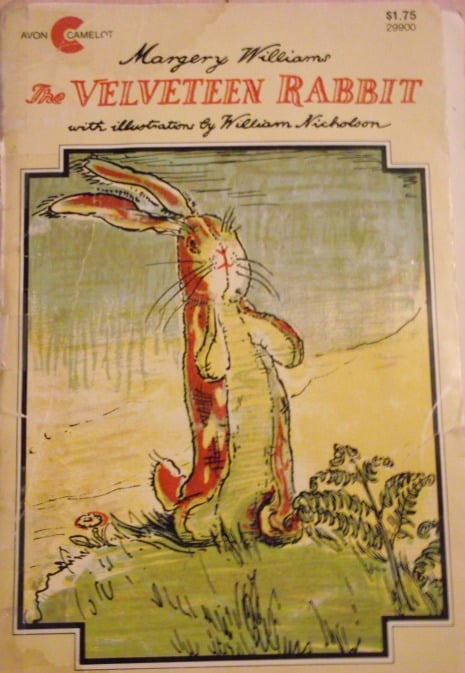The Velveteen Rabbit
Podcast: Play in new window | Download (0.0KB)
Subscribe: Apple Podcasts | Google Podcasts | RSS | More
Listen to an excerpt from this classic children’s novel. If you enjoy the beginning, you may want to read the whole book. It is short and sweet and contains an important message for children of all ages. If you have a reading group or a learning partner, this is a good book to read together.
The Velveteen Rabbit, or “How Toys Become Real,” by Margery Williams.
There was once a velveteen rabbit, and in the beginning he was really splendid. He was fat and bunchy, as a rabbit should be; his coat was spotted brown and white, he had real thread whiskers, and his ears were lined with pink sateen. On Christmas morning, when he sat wedged in the top of the Boy’s stocking, with a sprig of holly between his paws, the effect was charming.
There were other things in the stocking, nuts and oranges and a toy engine, and chocolate almonds and a clockwork mouse, but the Rabbit was quite the best of all. For at least two hours the Boy loved him, and then Aunts and Uncles came to dinner, and there was a great rustling of tissue paper and unwrapping of parcels, and in the excitement of looking at all the new presents the Velveteen Rabbit was forgotten.
For a long time he lived in the toy cupboard or on the nursery floor, and no one thought very much about him. He was naturally shy, and being only made of velveteen, some of the more expensive toys quite snubbed him. The mechanical toys were very superior, and looked down upon every one else; they were full of modern ideas, and pretended they were real. The model boat, who had lived through two seasons and lost most of his paint, caught the tone from them and never missed an opportunity of referring to his rigging in technical terms. The Rabbit could not claim to be a model of anything, for he didn’t know that real rabbits existed; he thought they were all stuffed with sawdust like himself, and he understood that sawdust was quite out-of-date and should never be mentioned in modern circles. Even Timothy, the jointed wooden lion, who was made by the disabled soldiers, and should have had broader views, put on airs and pretended he was connected with Government. Between them all the poor little Rabbit was made to feel himself very insignificant and commonplace, and the only person who was kind to him at all was the Skin Horse.
The Skin Horse had lived longer in the nursery than any of the others. He was so old that his brown coat was bald in patches and showed the seams underneath, and most of the hairs in his tail had been pulled out to string bead necklaces. He was wise, for he had seen a long succession of mechanical toys arrive to boast and swagger, and by-and-by break their mainsprings and pass away, and he knew that they were only toys, and would never turn into anything else. For nursery magic is very strange and wonderful, and only those playthings that are old and wise and experienced like the Skin Horse understand all about it.
“What is REAL?” asked the Rabbit one day, when they were lying side by side near the nursery fender, before Nana came to tidy the room. “Does it mean having things that buzz inside you and a stick-out handle?”
splendid (adjective): very nice
bunchy (adjective): sewn together in bunches (material)
wedge (verb): to place tightly between two things
charming (adjective): attractive in appearance and or manner
snub (verb): to look down on someone; to think you are better than another
rustling (noun): a dry crackling sound caused by movement of objects such as paper or leaves
a long succession (noun): a number of similar things or people that follow one another in order
Comprehension Questions
1. Describe the rabbit.
2. When is the story set?
3. Where did the boy find the rabbit?
4. Describe the Skin Horse.
5. What question does the rabbit ask the Skin Horse?
Discuss or Write
1. How do you think the Skin Horse will respond?
2. This story was written in 1922. How have toys changed since this time?
3. Tell your partner or class about a special toy or object you had as a child. Why did it mean so much to you?
Speaking Practice
Improve your pronunciation by practising reading aloud on MyEC. Record this excerpt and upload it to your own page on MyEC. Share your recording in the Audio Speaking Group.
The Velveteen Rabbit (also called How Toys Become Real), written by Margery Williams and illustrated by William Nicholson, was published in 1922.
Voice: Tara Benwell.
